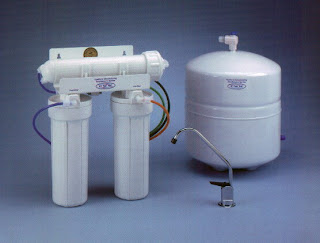What if I told you there are several types of water filtration systems on the market these days? With so many out there, it really makes it hard to choose which would be best for the home. The condominium I occupy had a reverse osmosis water system with changeable filters installed by the homeowner's association when the building was constructed over 25 years ago. I am very concerned about fitness, health and longevity, so I really decided to put this system to the test and see what it was all about. I really didn't know what a reverse osmosis water system did, so I happened onto the internet to see what information I could find out and decide if this was the best choice in water purity.
Reverse osmosis (RO) is a process by which pressure is used to force a solution through a semi-permeable membrane allowing passage of solvent but not solute. It's best known for being used for desalination (or removing the salt from sea water to make it fresh) however it has been used to purify things for the medical (dialysis), domestic and industrial (food industry, car washes, water plants) settings since the early 1970's.
In terms of drinking water purification, many homes use reverse osmosis systems as a common step for improving water for drinking, cooking and showering. This type of RO system includes several steps used to get water prepared for use. These included:
- A trapping device (sediment filter) for removing rust and calcium carbonate
- A secondary sediment filter with a finer openings
- An activated carbon filter used to remove volatile and soluble organic chemicals along with chlorine which can breakdown the RO membranes
- A RO filter/membrane
- Sometimes an optional second carbon filter and finally
- An ultra-violet lamp
This seemed like quite a few steps and rather expensive sounding too. Also, when I took the time to actually look at what else got removed with the toxins and sediment, I wasn't very impressed. Valuable minerals were removed from the water as well and I knew this was quite important to keep my body at a healthy balance. I didn't want my body becoming acidic or trying to strip minerals from other parts of the body such as teeth and bones. Plus, I would like to keep my organs for a long time to come and acidic water just isn't conducive to those conditions.
Some other disadvantages to a RO filtration for residential conditions were for every 5 gallons of useable water it would flush anywhere from 8-10 gallons that might get captured for watering the garden. It just seemed sort of wasteful if you ask me.
In conclusion, after much debate on my own part I decided to get rid of the reverse osmosis water system in my home. The disadvantages seemed to outweigh the positives, so in the end I selected a reasonably priced, multi-stage filtration system that included carbon, sub-micron filtering and ion exchange. I found did a much more thorough job in ridding the water in my home of nearly 99% of bacteria, viruses, germs, sediment, chemicals, drugs and anything else I could think of that could possibly come out of the faucets. So do yourself a favor, if health and longevity is paramount to you as well, compare and learn the same facts I did.
Laurel Tevolitz is a dedicated researcher of critical issues that affect health and well-being. Visit her water purification blog now at http://www.safewaterpurifier.com/pristinewater.htm to discover which water purification system she recommends after extensive research.
Article Source: http://EzineArticles.com/?expert=Laurel_Tevolitz


